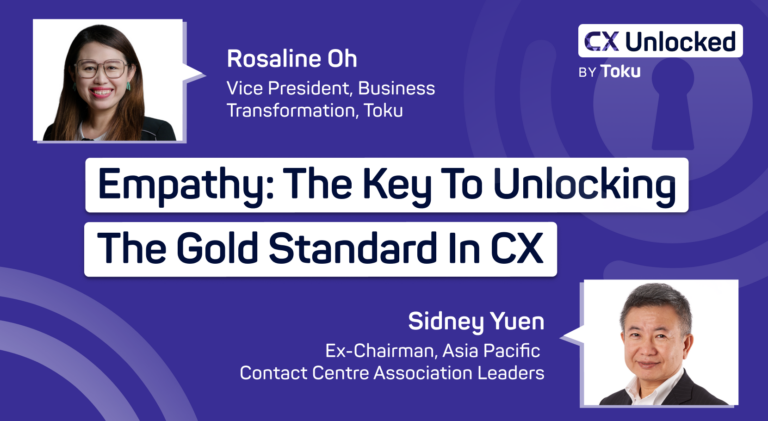Cloud-hosted phone systems are a great way to support and enhance communications, making them more efficient and ready for integration with other systems.
You reach out to customer service expecting the usual back-and-forth, but instead, you’re greeted with an immediate solution, tailored precisely to your needs. Before you’ve even explained your issue, the representative has anticipated your concerns, offering a resolution that feels personal and thoughtful.
Every interaction feels effortless, every response quick and empathetic. This is the kind of seamless experience that defines the gold standard in contact centres—where customers feel genuinely understood and valued, and where service excellence isn’t just a goal, but a consistent reality.
This level of foresight and service is not unlike the vision of Sidney Yuen, a veteran in the customer experience (CX) and contact centre industry, whom I had the pleasure of hosting as he shared his insights on our podcast series, CX Unlocked.
Sidney, with decades of leadership in Asia’s CX industry and extensive experience judging contact centre awards, shared invaluable insights into what defines a truly successful contact centre.
Listen to the full podcast episode here:
Join me as I unpack the key takeaways from this episode, sharing examples and insights that show how empathy can lead to better business outcomes.
What makes a gold standard contact centre?
As Sidney reflects on his experience judging contact centres across Asia, one thing stands out—the ability to foster a genuine connection with customers. While technology has undoubtedly transformed customer service, it’s the human touch that leaves a lasting impression.
Sidney shared a particularly striking example: a company shifted its debt collection approach from aggressive calls to using softer, empathetic tones. This seemingly small change resulted in higher resolution rates and more satisfied customers.
The lesson here is clear: empathy matters. Customers are more likely to engage positively with a company when they feel heard and understood.
In the contact centre world, the tone of voice, the phrasing of a response, and the emotional intelligence of the agent are as crucial as resolving the issue itself.
Winning contact centres, like winning organisations, know that emotional intelligence is not just a nice-to-have—it’s a necessity.
The pitfalls of a siloed approach
Despite many success stories, even award-winning organisations are not immune to pitfalls. We touched on a common mistake—viewing CX as a standalone department. He warned that this siloed mentality can quickly erode a company’s ability to deliver consistent, high-quality service.
He highlighted one thing—CX is everyone’s responsibility, from top management to front-line staff.
Sidney’s advice? It’s essential for leadership to lead by example. His point struck a chord with me, as I’ve seen firsthand how engagement shifts when it comes directly from the top.
I had a similar experience working with a government agency where the involvement of senior leadership created a noticeable impact.
When leadership actively participates and demonstrates a commitment to customer experience, it resonates throughout the entire organisation, inspiring employees to uphold the same high standards.
This shows that companies that succeed in CX don’t just pay lip service to it—they embed it into their culture, from the ground up.
Beyond the numbers: Are metrics enough?
Which brings me to the next point—resting on your laurels is a dangerous game. Even for companies that embed CX into their culture, staying stagnant in today’s business environment can quickly leave them behind.
Relying solely on traditional metrics like Customer Satisfaction (CSAT) scores or Net Promoter Scores (NPS) may no longer provide an accurate picture of success. These conventional KPIs, while helpful in the past, often fall short of capturing the complexities of modern customer expectations.
Sidney urged organisations to rethink how they measure success.
Averages can obscure serious issues. Sidney pointed out that averages, such as a 95% satisfaction score, can be deceptive. While it might look impressive on paper, it overlooks the crucial 5% of dissatisfied customers whose negative experiences could have significant implications for the business.
Customers today expect more than just resolution; they demand personalised, seamless experiences.
To truly excel, companies must move beyond static metrics and focus on continuous improvement and individual customer interactions, adapting in real time to shifting expectations.
Leveraging technology: The role of AI in CX
Technology and customer experience are inextricably linked.
Sidney referenced the philosophy shared by Bill Price in the first episode of CX Unlocked.
Bill Price, co-author of The Frictionless Organisation: Deliver Great Customer Experiences with Less Effort, expressed that “the best service is no service,” highlighting the ideal of eliminating the need for support by proactively addressing customer needs before issues arise.
You can watch the interview here:
–> Building a Truly Frictionless Experience: Exclusive Interview with Bill Price
If you would like to learn more about building and sustaining a frictionless organisation in the modern era, read the full article here.
Ideally, customers shouldn’t have to contact support at all—proactive service and intelligent systems should solve issues before they arise. AI is already transforming contact centres by handling routine queries and freeing up human agents to focus on more complex, high-value interactions.
But technology alone isn’t enough.
It is important to combine AI with human empathy. While AI can offer real-time solutions and insights, it’s the human agents who deliver those solutions with the care and understanding customers expectations.
The future of CX lies in blending technological efficiency with the uniquely human ability to connect on an emotional level.
Consistency is key: Meet rising expectations
Sidney shared a personal anecdote about staying at a hotel that went above and beyond to meet his preferences during his first visit, only to fall short on his return.
The inconsistency left him disappointed and underscores a vital point: customer expectations are always rising. Companies must deliver consistently excellent service, every time, to build lasting loyalty.
Consistency isn’t just about getting it right once. It’s about building robust systems that allow organisations to meet—and exceed—customer expectations at every touchpoint, time and time again.
The importance of proactivity in CX
Throughout the discussion, a recurring theme emerged: the need for proactivity in customer service. For example, some hotels have implemented proactive measures, like offering additional pillows for guests with neck problems before they even ask. This level of attentiveness creates a memorable experience and fosters deep customer loyalty.
Proactive service means anticipating customer needs and addressing them before they become issues. It’s about staying ahead of the curve, rather than reacting after the fact.
This approach not only improves customer satisfaction but also reduces the need for customers to reach out in the first place—saving both time and resources.
Moving forward: Lessons for businesses
In conclusion, CX excellence begins with empathy, moves through consistency, and is powered by technology.
But the journey doesn’t end there. Companies must also remain agile, continuously adapting to meet changing customer expectations.
Businesses must view customer experience as a company-wide priority. It’s not the responsibility of a single department—it’s embedded in every interaction, every process, and every decision. Only then can organisations truly unlock CX excellence.
Learn from the CX veteran
Discover valuable insights from our interview with Sidney Yuen.
 Rosaline Oh
Rosaline Oh 


 Nora Huin
Nora Huin 
 V K Sanjeed
V K Sanjeed 